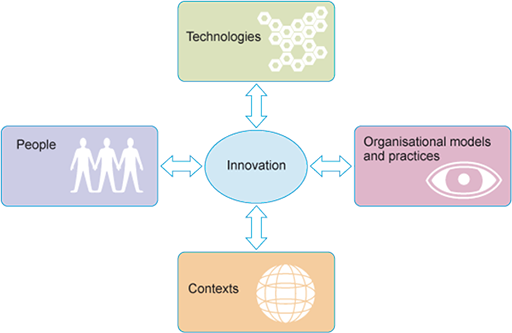13 Tick the PTOC factors!
There are four ‘key lenses’ through which technology and innovation management in organisations could and probably should be considered, as illustrated in Figure 9. This refers to the role of people, technological, organisational and contextual (PTOC) factors in conditioning and shaping innovation outcomes and impacts in real-world contexts. In turn, we recognise that technological innovation will shape people, technology, organisations and contexts. This means that considering PTOC factors is important for effective technology and innovation management. For shorthand, we refer to ‘Tick the PTOC factors’.
Activity 6: ‘Tick the PTOC factors’ in technology and innovation management
So, what might ‘Tick the PTOC factors’ mean in technology and innovation management? Jot down a few thoughts about the role of people, technological, organisational and contextual (PTOC) factors.
| Role of PTOC factors | Issues for Technology and Innovation Management |
|---|---|
| People | |
| Technology | |
| Organisation | |
| Context |
Answer
The term ‘Tick the PTOC factors’ means considering the PTOC factors in technological innovation both shaping and being shaped by innovation.
Here are a few introductory thoughts about the role of people, technological, organisational and contextual (PTOC) factors that should be considered in technology and innovation management.
| Role of PTOC factors | Issues for Technology and Innovation Management |
|---|---|
| People | The role of people driving, enabling and impacted by innovation, and related issues. Such people might be individual inventors, innovators, entrepreneurs, intrapreneurs, project champions, customers and users, but might also be groups, organisations or intermediaries (e.g. designers, marketers, suppliers, the media, etc.), or stakeholders involved with innovation and innovation management. |
| Technology | The role of technologies, including artefacts, knowledge or ‘modes of enquiry’, and technological change in innovation and innovation management. |
| Organisational factors | The role of organisational models and practices associated with an organisation’s approach to innovation management. |
| Context | The role of context shaping and being shaped by the context for innovation and innovation management. Contextual factors and features can be spatial, temporal and human-constructed (e.g. technological, organisational, sectoral, social, political, economic and environmental factors). |
In your study and practice of technology and innovation management, we recommend you ‘Tick the PTOC factors’ by considering the role of people, technological, organisational and contextual (PTOC) factors in innovation – both influencing and being influenced by innovation.
From the review, we can suggest that innovation management involves the strategic management of people, technology, organisational and contextual (PTOC) factors to create preconditions to promote effective searching for ideas and technologies, and then selecting suitable ideas for development, implementation and introduction as innovations into a dynamic context (commercial or social), with the intention of capturing and creating the maximum value of an innovation.

